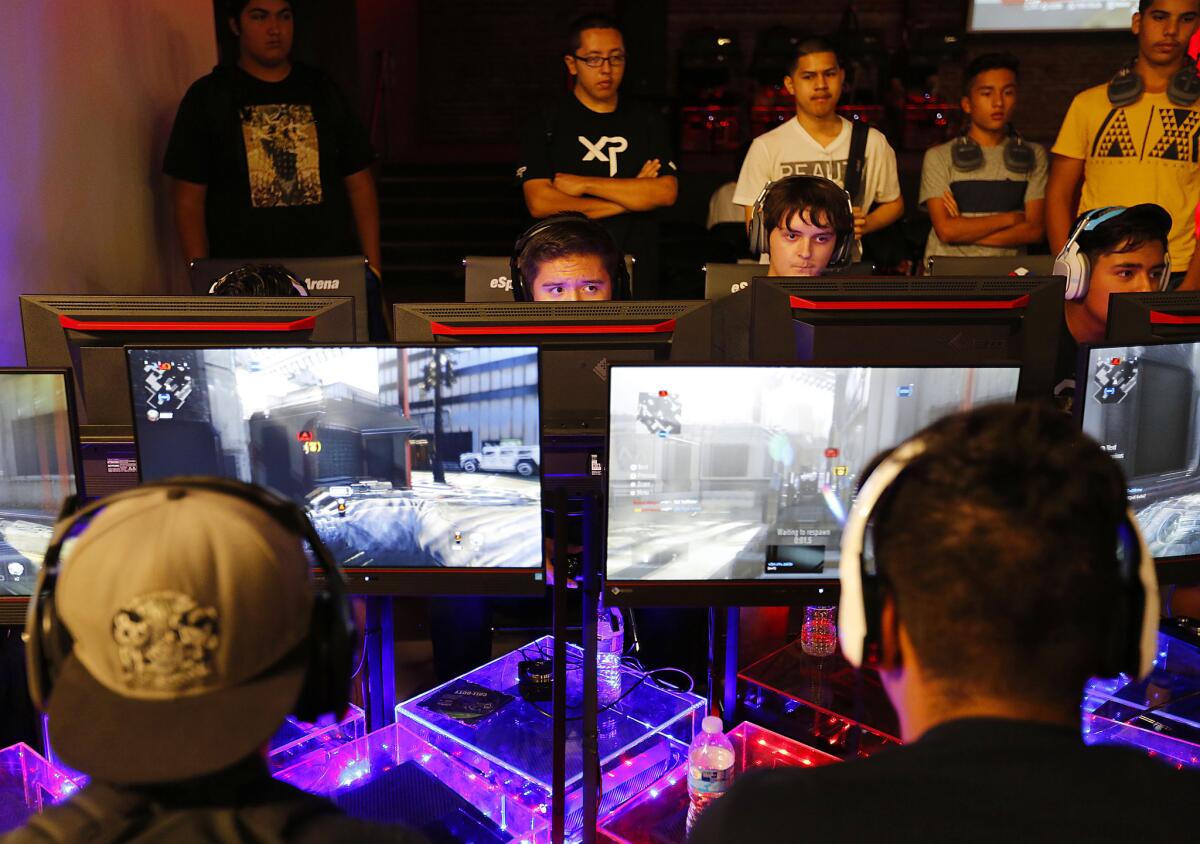Competitive video game players get a big-time stage in Santa Ana

A new venue for video game competitions, eSports Arena, is hosting a “Call of Duty” tournament throughout the weekend.
On Oct. 3, nearly a thousand people will fill Southern California’s newest sports arena, spending up to $75 a seat to watch teams from across the continent battle for bragging rights — and at least $20,000.
Twenty-four top stars will compete, not in a kick-boxing ring or on a basketball court, but sitting at computers. The video game action will be projected on giant screens as spectators watch players cast spells online and slay enemies with virtual weaponry.
The spectacle kicks off the new eSports Arena in Santa Ana, a 15,000-square-foot, first-of-its-kind U.S. gym and recreation center designed for video gaming. In recent years, video game makers and event organizers have aggressively expanded the professional tournament circuit. They increasingly see competitive gaming as a lucrative business opportunity, a way to turn video gaming into a global spectator sport.
See the most-read stories this hour >>
Playing video games has grown so competitive that 11,000 people last month flocked to Madison Square Garden to watch the finals of a “League of Legends” tournament. Millions more spectators gathered in living rooms, bars, movie theaters and restaurants to watch the live stream.
It’s adding up to a fast-growing business, with $612 million in worldwide revenue expected this year from sponsorships, ticket fees and merchandise sales, according to gaming consultancy SuperData Research. But the 134 million fans haven’t had many permanent establishments where they can play and watch.
By filling that gap, eSports Arena serves as a major test of how far the young community’s enthusiasm will stretch.
Tyler Endres and Paul Ward, childhood friends stuck in the semi-pro gaming level, co-founded the arena after spotting an opportunity. Traditional gaming cafes and eSports promoters held only sporadic events. Endres and Ward knew they could offer frequent, local competitions — and a place for amateur gamers to practice, mingle and feel like a champion by playing on stage.
Like a gym, eSports Arena offers memberships and passes. It also organizes leagues and hosts events like the “Hearthstone” tournament Oct. 3-4, which will draw big-league stars. Other event organizers may rent the space, which along with sponsorships and online broadcast advertising will generate revenue.
Edward Zhao of gaming consultancy Electronic Entertainment Design and Research in Carlsbad called eSports Arena “another step offering validation that eSports is here to stay.”
It’s just one approach to ride the growth in the nascent eSports industry. This year, game developer Riot Games opened an arena in West Los Angeles. Online broadcaster Major League Gaming opened a 500-seat venue in Columbus, Ohio, last fall, with plans for an 18,000-seat stadium in China in 2017. Although fans can buy tickets to matches, those operations don’t accommodate casual players on a daily basis.
Super League Gaming, a Santa Monica start-up, is running competitions inside movie theaters for the first time this fall by renting them out during slow hours. In United Kingdom, gaming company Affinity permanently transformed a film theater into a gaming-events center earlier this year.
Howie’s Game Shack — a decade-old, small chain of hang-out spots for gamers with gaming devices galore — is embarking on a major renovation to boost its ability to host competitions as fans drink beer and wine from their seats. First up is the Mission Viejo location.
“There’s no question that there’s more interest than there has ever been,” Chief Executive Howard Maker said.
Howie’s Game Shack and eSports Arena fundamentally don’t differ much from fitness centers Soul Cycle and Cross Fit or electronic music events put on by promoter Insomniac. They’ve succeeded by giving niche communities a physical space to congregate, analysts said.
Joost van Dreunen, chief executive of SuperData and an adjunct professor at New York University’s game center, compared amateur brackets at eSports Arena to his old, Monday-night billiards league.
“Once you understand video games through that lens, it suddenly doesn’t seem too odd that people like to compete, practice and share these experiences,” he said. “Video gaming has become a mainstream form of entertainment, allowing it the critical mass necessary to make something like an eSports Arena financially sustainable.”
ESports Arena is housed in a renovated, nearly century-old brick building in a quickly gentrifying downtown Santa Ana that’s become home to hipster stores and organic eateries. The arena could spur further change: In Columbus, the tourism bureau found that the MLG arena led to $4 million in visitor spending in less than a year.
A new power vault was sunk into the street to handle the arena’s huge electricity demands. Two fast Internet connections — one for backup — were bought. The company’s also making major investments to secure computers from hackers, who seek to disrupt tournaments for fun.
Sponsors such as Corsair, Eizo and CyberPowerPC provide the gaming equipment, including 130 computer stations and 64 Xbox consoles neatly arranged on the arena floor.
There’s also room for a players’ lounge, office space and video production. Space outside could handle red carpet events, say the launch of a new game.
Ward and Endres hope the arena’s stage and broadcast set become a focal point for Southern California eSports.
The arena plans to live stream daily amateur battles. Endres said friends and relatives of college students could go online to watch them play on stage. Commentators and award ceremonies will add to the aura.
“We’re selling an experience, not Internet time,” Endres said.
The ideas trace back eight years when as Azusa Pacific University freshmen Endres and Ward organized campus tournaments for the “Halo 2” Xbox game. The pair knocked on dorms to borrow TVs and Xboxes. They got enough for 100 players in their first tournament.
This time around, Endres and Ward solicited investors and sponsors. They received a Small Business Administration loan, checks from friends and family and a large investment from an individual unconnected to the gaming industry.
They looked in Irvine, close to game developers and large universities. But Santa Ana had more parking and restaurants.
On a Sunday afternoon in August, about 120 people streamed through the arena for a soft-launch viewing party for the “League of Legends” championship broadcast.
Victor Hernandez and his 11-year-old son, Ryan, sat in the front row.
“It’s like being at a football game,” the dad said. “It’s one thing to see a nice play. Hearing the crowd react makes it better.”
The ability to play their games during intermissions lured some from viewing parties at theaters and elsewhere. Roblen Guevarra, a UC Irvine graduate, and her friend Scott Nieblas, a senior there, stream matches to a TV most weekends. They were as hooked at the arena, heads cocked, mesmerized as characters dodged lasers, swords and spears.
Players hollered at slayings in rapid succession, but mostly “ahhed” in awe of deft moves by the two teams of five.
Peter DePaola and Austin January, seniors at a high school near the arena, said the facility beats lunchtime club meetings where they talk about games.
“When you see so many people into what you are, even if it’s nerdy, it’s a community,” January said.
Twitter: @peard33
ALSO:
Stakes are high for Apple going into ‘critical event’
Virtual reality companies lure gamers into new worlds
Abcarian: Anita Sarkeesian bravely confronts sexist video gaming culture







